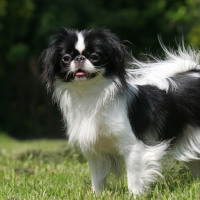Appearance of the Japillon
|
| The Japillon's parent breeds, the Japanese Spaniel and the Continental Toy Spaniel, are of equal size and weight, making it easy to predict the Japillon's size. The Japillon is a toy-sized dog that measures less than 28 centimeters and weighs no more than 4 kilos. The head is round and the muzzle varies from slight to flat, depending on which parent breed the dog most resembles. The bite is scissor-like and the lips are tight. The Japillon's body is delicately boned, with slender legs and a compact body. The coat is silky and the tail is heavily feathered and curls over the back. |
Temperament of the Japillon
|
| The Japillon is very affectionate with the family and demands a lot of attention. It has a gentle disposition and resembles a cat in its movement. The Japillon loves children but may not be suitable for young children, who may be too rough for the delicately boned dog. Despite its toy size, the Japillon is an excellent watchdog that won't attack but will bark at strangers until asked to stop. The parent Continental Toy Spaniel likes to please, and chances are the Japillon is eager to please and will train well. However, the Japanese Spaniel can add elements of stubbornness and make training slightly more difficult. The Japillon is a playful hybrid with moderate to medium energy. |
Needs and activities of the Japillon
|
| The Japillon is a hybrid with medium energy levels and variable intensity requirements. A few short walks a day should be enough exercise for the Japillon. The Japillon can do all its exercise indoors and is ideally suited to apartment living. This hybrid also prefers warmer climates to colder ones, but does not tolerate extreme weather conditions. However, climate tolerance is somewhat irrelevant given that the Japillon is a domestic dog and spends most of its time indoors. This hybrid will appreciate time spent outdoors, however, so be sure to keep an eye on it at all times, as even a fenced yard may have an area you're not aware of that could allow this little dog to escape. |
Maintenance of the Japillon
|
| The unique silky coat is not prone to matting, but weekly brushing will help maintain the Japillon's coat. Frequent brushing will also help distribute the natural oils on the Japillon's skin. Bathing is not suggested unless necessary, as bathing can strip the skin of its natural oils and lead to dermatitis. The hair around the ears and legs is longer than the rest of the coat and requires special attention to avoid tangles. Long hair around the ears can also trap dirt, debris and moisture. Check your Japillon's ears during grooming to clean them with a vet-approved solution. The Japillon sheds very little and can be considered a hypoallergenic hybrid. The hybrid is not known for drooling and has no doggy odor. |

























 English (United Kingdom)
English (United Kingdom)